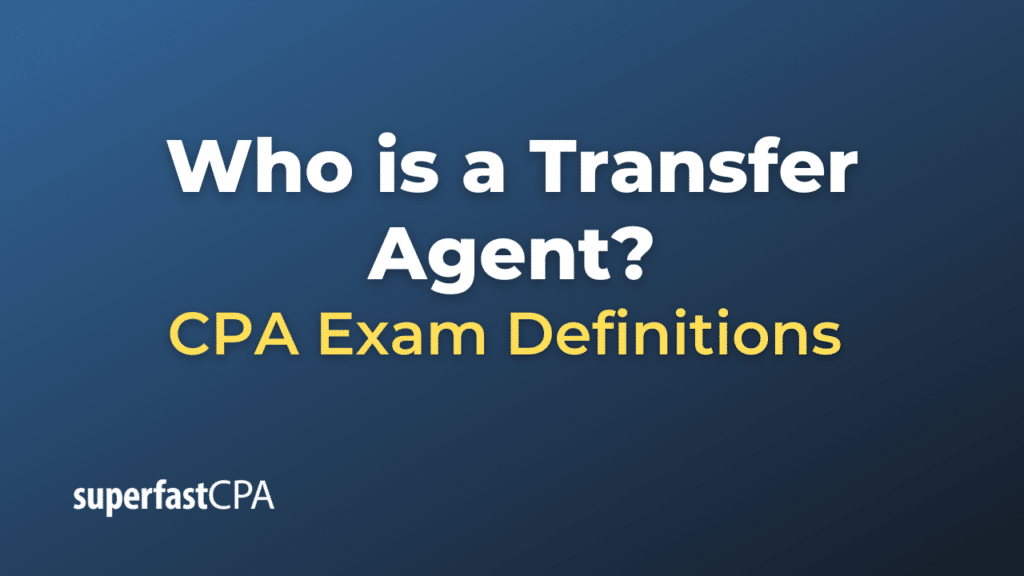Transfer Agent
A transfer agent is a trusted institution or third-party entity appointed by a corporation or mutual fund to track and manage the ownership records of its securities (such as stocks or bonds) and to handle related tasks. Transfer agents play a pivotal role in the capital markets and serve both public companies and mutual fund providers. Here’s what a transfer agent typically does:
- Recordkeeping: They maintain the official master shareholder register for a corporation or mutual fund, ensuring an accurate and updated record of each investor’s holdings.
- Transfers: If a shareholder sells their shares, the transfer agent facilitates the change of ownership. This means that they ensure the old share certificates are canceled and the new owner receives a new certificate (if physical certificates are still used).
- Dividends and Distributions : They handle the distribution of dividends to shareholders or distributions to mutual fund investors.
- Communications: Transfer agents assist in communicating important information to shareholders, like notices of annual general meetings or other pertinent materials.
- Lost Shareholders: They can help trace lost shareholders, for example, those who might have forgotten about shares they own or who have unclaimed dividends.
- Proxy Voting: They manage the process of proxy voting, ensuring shareholders receive their proxy materials and collecting and tallying votes.
- Issuance: They issue shares for new investors, whether it’s due to a public offering, a dividend reinvestment plan, or other stock purchase plans.
In many countries, including the United States, transfer agents are required to be registered with regulatory bodies and are expected to adhere to specific standards and regulations to ensure the accuracy and integrity of their services.
Example of a Transfer Agent
Let’s use a hypothetical example to illustrate how a transfer agent operates:
Scenario: Jane buys shares of XYZ Corporation, a publicly traded company on the New York Stock Exchange. She buys her shares through an online brokerage platform.
Step 1: Recordkeeping
Once Jane’s purchase is complete, the transfer agent for XYZ Corporation will record Jane’s details and her ownership of the shares in the company’s official shareholder register. Jane doesn’t need to interact with the transfer agent directly; the brokerage and the transfer agent will handle the details behind the scenes.
Step 2: Dividends
A few months later, XYZ Corporation announces a dividend payment to its shareholders. The transfer agent is responsible for calculating the amount of dividend Jane is entitled to based on the number of shares she owns. They will then distribute this dividend, either by sending Jane a check or by crediting her brokerage account.
Step 3: Proxy Voting
XYZ Corporation is about to have its Annual General Meeting (AGM). Prior to this meeting, the transfer agent sends out proxy materials to all shareholders, including Jane. This material allows Jane to vote on various company matters, even if she doesn’t attend the AGM in person. Jane makes her selections and sends back the proxy card. The transfer agent then tallies all proxy votes in preparation for the AGM.
Step 4: Transfers
After a couple of years, Jane decides to sell half of her shares. When she executes this sale through her online brokerage, the transfer agent facilitates the change of ownership from Jane to the new owner by updating the official shareholder register.
Step 5: Lost Shareholders
Jane moves to a new address and forgets to update her details with her brokerage. The next time dividends are distributed or proxy materials are sent out, they can’t reach her. The transfer agent then flags her as a “lost shareholder.” They might undertake efforts to locate her or use a third-party service to update her contact details.
Throughout this entire process, Jane might never directly interact with the transfer agent, but the agent plays a crucial role in ensuring that her ownership rights are acknowledged, her dividends are paid, and her votes are counted.













